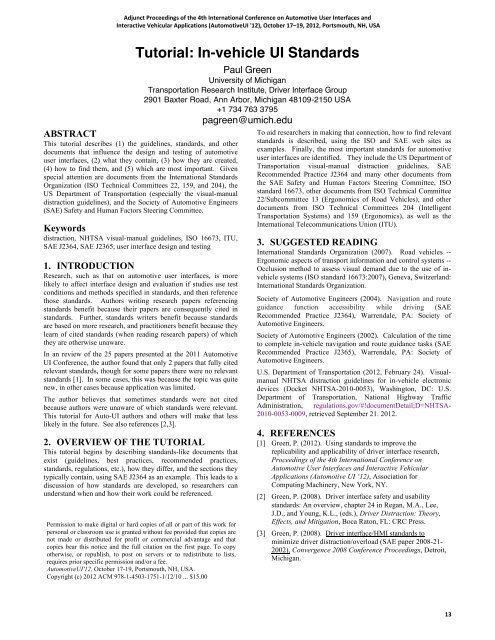12: Adjunct Proceedings - Automotive User Interfaces and ...
12: Adjunct Proceedings - Automotive User Interfaces and ...
12: Adjunct Proceedings - Automotive User Interfaces and ...
Create successful ePaper yourself
Turn your PDF publications into a flip-book with our unique Google optimized e-Paper software.
<strong>Adjunct</strong> <strong>Proceedings</strong> of the 4th International Conference on <strong>Automotive</strong> <strong>User</strong> <strong>Interfaces</strong> <strong>and</strong><br />
Interactive Vehicular Applications (<strong>Automotive</strong>UI '<strong>12</strong>), October 17–19, 20<strong>12</strong>, Portsmouth, NH, USA<br />
Tutorial: In-vehicle UI St<strong>and</strong>ards<br />
ABSTRACT<br />
This tutorial describes (1) the guidelines, st<strong>and</strong>ards, <strong>and</strong> other<br />
documents that influence the design <strong>and</strong> testing of automotive<br />
user interfaces, (2) what they contain, (3) how they are created,<br />
(4) how to find them, <strong>and</strong> (5) which are most important. Given<br />
special attention are documents from the International St<strong>and</strong>ards<br />
Organization (ISO Technical Committees 22, 159, <strong>and</strong> 204), the<br />
US Department of Transportation (especially the visual-manual<br />
distraction guidelines), <strong>and</strong> the Society of <strong>Automotive</strong> Engineers<br />
(SAE) Safety <strong>and</strong> Human Factors Steering Committee.<br />
Keywords<br />
distraction, NHTSA visual-manual guidelines, ISO 16673, ITU,<br />
SAE J2364, SAE J2365, user interface design <strong>and</strong> testing<br />
1. INTRODUCTION<br />
Research, such as that on automotive user interfaces, is more<br />
likely to affect interface design <strong>and</strong> evaluation if studies use test<br />
conditions <strong>and</strong> methods specified in st<strong>and</strong>ards, <strong>and</strong> then reference<br />
those st<strong>and</strong>ards. Authors writing research papers referencing<br />
st<strong>and</strong>ards benefit because their papers are consequently cited in<br />
st<strong>and</strong>ards. Further, st<strong>and</strong>ards writers benefit because st<strong>and</strong>ards<br />
are based on more research, <strong>and</strong> practitioners benefit because they<br />
learn of cited st<strong>and</strong>ards (when reading research papers) of which<br />
they are otherwise unaware.<br />
In an review of the 25 papers presented at the 2011 <strong>Automotive</strong><br />
UI Conference, the author found that only 2 papers that fully cited<br />
relevant st<strong>and</strong>ards, though for some papers there were no relevant<br />
st<strong>and</strong>ards [1]. In some cases, this was because the topic was quite<br />
new, in other cases because application was limited.<br />
The author believes that sometimes st<strong>and</strong>ards were not cited<br />
because authors were unaware of which st<strong>and</strong>ards were relevant.<br />
This tutorial for Auto-UI authors <strong>and</strong> others will make that less<br />
likely in the future. See also references [2,3].<br />
2. OVERVIEW OF THE TUTORIAL<br />
This tutorial begins by describing st<strong>and</strong>ards-like documents that<br />
exist (guidelines, best practices, recommended practices,<br />
st<strong>and</strong>ards, regulations, etc.), how they differ, <strong>and</strong> the sections they<br />
typically contain, using SAE J2364 as an example. This leads to a<br />
discussion of how st<strong>and</strong>ards are developed, so researchers can<br />
underst<strong>and</strong> when <strong>and</strong> how their work could be referenced.<br />
Permission to make digital or hard copies of all or part of this work for<br />
personal or classroom use is granted without fee provided that copies are<br />
not made or distributed for profit or commercial advantage <strong>and</strong> that<br />
copies bear this notice <strong>and</strong> the full citation on the first page. To copy<br />
otherwise, or republish, to post on servers or to redistribute to lists,<br />
requires prior specific permission <strong>and</strong>/or a fee.<br />
<strong>Automotive</strong>UI'<strong>12</strong>, October 17-19, Portsmouth, NH, USA.<br />
Copyright (c) 20<strong>12</strong> ACM 978-1-4503-1751-1/<strong>12</strong>/10 ... $15.00<br />
Paul Green<br />
University of Michigan<br />
Transportation Research Institute, Driver Interface Group<br />
2901 Baxter Road, Ann Arbor, Michigan 48109-2150 USA<br />
+1 734 763 3795<br />
pagreen@umich.edu<br />
To aid researchers in making that connection, how to find relevant<br />
st<strong>and</strong>ards is described, using the ISO <strong>and</strong> SAE web sites as<br />
examples. Finally, the most important st<strong>and</strong>ards for automotive<br />
user interfaces are identified. They include the US Department of<br />
Transportation visual-manual distraction guidelines, SAE<br />
Recommended Practice J2364 <strong>and</strong> many other documents from<br />
the SAE Safety <strong>and</strong> Human Factors Steering Committee, ISO<br />
st<strong>and</strong>ard 16673, other documents from ISO Technical Committee<br />
22/Subcommittee 13 (Ergonomics of Road Vehicles), <strong>and</strong> other<br />
documents from ISO Technical Committees 204 (Intelligent<br />
Transportation Systems) <strong>and</strong> 159 (Ergonomics), as well as the<br />
International Telecommunications Union (ITU).<br />
3. SUGGESTED READING<br />
International St<strong>and</strong>ards Organization (2007). Road vehicles --<br />
Ergonomic aspects of transport information <strong>and</strong> control systems --<br />
Occlusion method to assess visual dem<strong>and</strong> due to the use of invehicle<br />
systems (ISO st<strong>and</strong>ard 16673:2007), Geneva, Switzerl<strong>and</strong>:<br />
International St<strong>and</strong>ards Organization.<br />
Society of <strong>Automotive</strong> Engineers (2004). Navigation <strong>and</strong> route<br />
guidance function accessibility while driving (SAE<br />
Recommended Practice J2364), Warrendale, PA: Society of<br />
<strong>Automotive</strong> Engineers.<br />
Society of <strong>Automotive</strong> Engineers (2002). Calculation of the time<br />
to complete in-vehicle navigation <strong>and</strong> route guidance tasks (SAE<br />
Recommended Practice J2365), Warrendale, PA: Society of<br />
<strong>Automotive</strong> Engineers.<br />
U.S. Department of Transportation (20<strong>12</strong>, February 24). Visualmanual<br />
NHTSA distraction guidelines for in-vehicle electronic<br />
devices (Docket NHTSA-2010-0053), Washington, DC: U.S.<br />
Department of Transportation, National Highway Traffic<br />
Administration, regulations.gov/#!documentDetail;D=NHTSA-<br />
2010-0053-0009, retrieved September 21. 20<strong>12</strong>.<br />
4. REFERENCES<br />
[1] Green, P. (20<strong>12</strong>). Using st<strong>and</strong>ards to improve the<br />
replicability <strong>and</strong> applicability of driver interface research,<br />
<strong>Proceedings</strong> of the 4th International Conference on<br />
<strong>Automotive</strong> <strong>User</strong> <strong>Interfaces</strong> <strong>and</strong> Interactive Vehicular<br />
Applications (<strong>Automotive</strong> UI ‘<strong>12</strong>), Association for<br />
Computing Machinery, New York, NY.<br />
[2] Green, P. (2008). Driver interface safety <strong>and</strong> usability<br />
st<strong>and</strong>ards: An overview, chapter 24 in Regan, M.A., Lee,<br />
J.D., <strong>and</strong> Young, K.L., (eds.), Driver Distraction: Theory,<br />
Effects, <strong>and</strong> Mitigation, Boca Raton, FL: CRC Press.<br />
[3] Green, P. (2008). Driver interface/HMI st<strong>and</strong>ards to<br />
minimize driver distraction/overload (SAE paper 2008-21-<br />
2002), Convergence 2008 Conference <strong>Proceedings</strong>, Detroit,<br />
Michigan.<br />
13





